
A Guide to the Amphibians
and Reptiles of California
Identifying Lizards Found in California - an Expanded Photo Index
Click on a picture for a larger view
| This is a species list with photos, range maps, and information to help identify every kind of lizard established in California. Some species are variable in appearance, and many lizards can change color, so be aware that not every possible variation of every species is shown here. Pictures of juveniles are shown here if I have them. Besides being smaller, they sometimes look considerably different from adults. |
|
| Scroll down the page and look at the pictures to find the lizard you are looking for. Since this page contains a lot of information that can be overwhelming at first, you might want to look at these simpler pages first: Commonly Encountered California Lizards - This shows a few species that I have been most often asked to identify. Photo Index of California Lizards - This shows only one picture of each kind of lizard found in the state. California Lizards Range Maps - You can look here to more easily find what lizards occur in the area where the lizard you want to identify was observed. Lizards found in coastal Southern California Lizards found in the Bay Area Lizards found in the Sacramento Area |
| When you find a lizard that looks right, check the range map on the far right to confirm that the lizard is found at the location where you found it. (You can enlarge a range map by clicking on it.) If your lizard is not found in the right location, keep on searching - lizards don't stray very far from their range, though they do sometimes show up in areas not yet marked on the map, and sometimes they are transported outside their range. Click the Latin name link to go to the species page with more pictures and a description of the lizard and its behavior that can help with the ID. There are several species of non-native lizards that have been released into the state and have successfully established populations. These established non-native lizards are shown at the bottom of the page. If you don't find your lizard anywhere here, you can look at these pages: Non-native Lizards That are Possibly Established but have not been officially documented; Some of the more common Escaped Pet Lizards that I have been asked to identify that were found at large in the state. If you are unable to make an identification, email me, inlcude a picture if possible and tell me the city where the lizard was seen, and I can probably identify it for you. If you find a species of lizard that definitely is not shown on this list, I'm especially interested in seeing pictures of it. |
|
| ____________________________________________________________________________________________________________________________ The lizards on this page are grouped by genus, then species, then subspecies. (Species in a genus are related and tend to be similar in appearance,) 19 genera of native lizards are found in California along with 8 genera of non-native lizards. (Each genus includes a Common Name and a Latin Name.) If you have an idea of what kind of lizard you are looking for, you can go directly to the genus by following these links: Western Alligator Lizards - genus Elgaria North American Legless Lizards - genus Anniella Collared Lizards - genus Crotaphytus Leopard Lizards - genus Gambelia Banded Geckos - genus Coleonyx Leaf-toed Geckos - genus Phyllodactylus Gila Monsters - genus Heloderma Desert Iguanas - genus Dipsosaurus Chuckwallas - genus Sauromalus Zebra-tailed Lizards - genus Callisaurus Banded Rock Lizards - genus Petrosaurus Horned Lizards - genus Phrynosoma Spiny Lizards - genus Sceloporus Fringe-toed Lizards - genus Uma Tree and Brush Lizards - genus Urosaurus Common Side-blotched Lizard - Uta stansburiana Toothy Skinks - genus Plestiodon Whiptails - genus Aspidoscelis Night Lizards - genus Xantusia Established Non-Native Lizards Anoles - genus Anolis House Geckos - genus - Hemidactylus Wall Geckos - genus Tarentola Whiptails - genus Aspidoscelis Afro-Malagasy mabuyas (Skinks) - Trachylepis Trioceros - Chameleons - Trioceros Wall Lizard - Podarcis |
More Lists And Information About California Lizards
Western Alligator Lizards - genus Elgaria |
|||||||
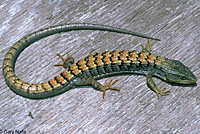 |
Alligator Lizards are fairly large, slow-moving, diurnal lizards. They are often found around suburban houses, yards, gardens, and garages, as well as in natural areas. Mostly seen on the ground, but sometimes seen climbing on bushes, trees, or even screen doors. Small juveniles look much different from adults. During the spring breeding season, it is not uncommon to see one lizard biting the neck of another lizard, sometimes holding on for hours. Large adults can grow up to 7 inches long, not including the tail, and up to 16 inches long including the tail (17.8 - 40.6 cm). Three species of Western Alligator Lizards are found in California: Northern Alligator Lizard, with four subspecies; Southern Alligator Lizard, with two subspecies; and Panamint Alligator Lizard. Unfortunately, the species are similar in appearance and cannot always be easily identified from a distance in areas where two species overlap. You will need to get a close-up look at the eyes, and sometimes you need to have the lizard in hand to look at the underside, but be careful, they can bite hard. More About Alligator Lizard Identification |
||||||
| Physical Features to Observe When Identifying an Alligator Lizard |
 |
 |
 |
 |
 |
 |
 |
| Body is about 7 inches long (17.8 cm) not including the tail which can be longer than the body. The tail is often broken off and re-grows differently from the original as seen here. | The body is large and robust, usually with distinct markings on the back. Unbroken tails can be very long. |
Juveniles look much different than adults. The back is unmarked or only faintly marked. They are often confused for a different species. | Large keeled scales on back | Long alligator-like snout | There is a longitudinal fold on the lower sides of the body. |
Spring courtship behavior © Joy Lutz-Mizar |
|
| Northern Alligator Lizard - Elgaria coerulea - Four subspecies are found in California |
|||||||
| Physical Features to Observe When Identifying a Northern Alligator Lizard |
 |
 |
 |
 |
 |
||
| Dark marks or stripes run lengthwise between the rows of scales on the belly. Compare with the dark belly stripes of the Southern Alligator Lizard (below) found in the center of the scales. |
The eye around the pupil is dark compared with the lighter eye of the Southern Alligator Lizard (below). |
Juveniles are small with smooth-looking skin like a skink with more of a solid-looking bronze or brown color than adults. | |||||
| San Francisco Alligator Lizard Elgaria coerulea coerulea |
 |
 |
 |
 |
 |
 |
 |
| Adult | Adult | Adult | Adult | Juvenile | Underside | Found in the red area | |
| Sierra Alligator Lizard Elgaria coerulea palmeri |
 |
 |
 |
 |
 |
 |
 |
| Adult | Adult | Adult | Adult | Juvenile | Underside | Found in the orange area | |
| Northwestern Alligator Lizard Elgaria coerulea principis |
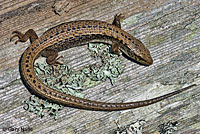 |
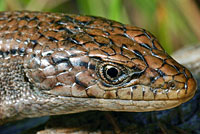 |
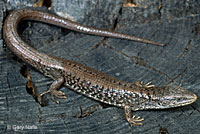 |
 |
 |
 |
 |
| Adult | Adult |
Adult | Adult © Alan Barron | Juvenile | Underside | Found in the bright purple area | |
| Shasta Alligator Lizard Elgaria coerulea shastensis |
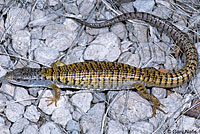 |
 |
 |
 |
 |
 |
 |
| Adult female | Adult | Some adult males have bright yellow backs and bellies with blue-gray heads. © Gene Sederholm |
Adult | Juvenile | Underside | Found in the dark blue area | |
| Southern Alligator Lizard - Elgaria multicarinata -Two subspecies are found in California |
|||||||
| Physical Features to Observe When Identifying a Southern Alligator Lizard |
 |
 |
 |
© Jay Keller |
 |
||
| Dark marks or stripes run lengthwise through the center of the scales on w the belly. Compare with the dark belly stripes of the Northern Alligator Lizard (above) which are found between the scales. |
The eye around the pupil is light compared with the the darker eye found on the Northern Alligator Lizard (above). |
Juveniles are small with smooth-looking skin like a skink and more of a solid bronze or brown color than adults. | |||||
| Forest Alligator Lizard (California Alligator Lizard) Elgaria multicarinata multicarinata |
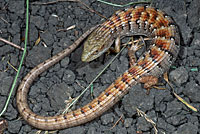 |
 |
 |
 |
 |
 |
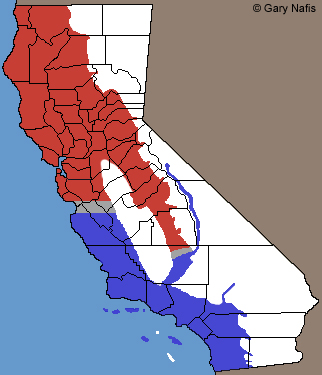 |
| Adult | Adult | Adult | Adult | Juvenile | Underside | Found in the red area | |
| Woodland Alligator Lizard (San Diego Alligator Lizard) Elgaria multicarinata webbii |
 |
 |
 |
 |
 |
 |
 |
| Adult | Adult | Adult | Adult | Juvenile © Jay Keller | Underside | Found in the dark blue area | |
| Panamint Alligator Lizard Elgaria panamintina |
 |
 |
 |
 |
 |
 |
 |
| Adult | Adult | Adult | Adult © Adam Clause. | Juvenile © Brad Alexander | Underside | Found in the red area | |
North American Legless Lizards - genus Anniella |
|||||||
 |
Small, slender, smooth-skinned lizards without legs, that mostly live in areas with soft sandy soil or abundant leaf litter into which they bury themselves. Often mistaken for snakes or large worms (but they have eyelids and detachable tails.) Adults grow to about 7 inches in length, including the tail (17.8 cm). 5 species are found in California (with a 6th form found along Monterey Bay that is often treated as a subspecies): Temblor Legless Lizard, Big Spring Legless Lizard, Bakersfield Legless Lizard, San Diegan Legless Lizard, and Northern Legless Lizard (including the Black Legless Lizard.) The best way to identify the species is to use the range map, but some of them can be identified by the dark stripes on the length of the body or by the color of the underside, |
||||||
| Physical Features to Observe When Identifying a Legless Lizard |
 |
 |
 |
 |
 |
||
| Slender body, about 7 inches long when adult. |
Unlike every other form of lizard in the state, legless lizards do not have legs. | Eyelids are present, but difficult to see unless the lizard blinks. |
The tail can be broken off, unlike the tail of a snake. |
The body is covered with smooth cycloid scales. |
|||
| Temblor Legless Lizard Anniella alexanderae |
 |
 |
 |
 |
 |
 |
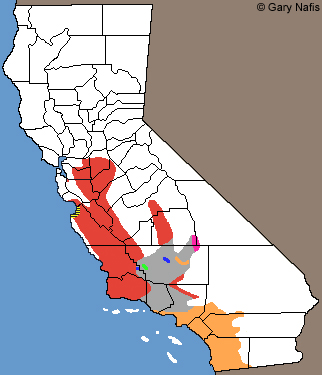 |
| Adult | Adult | Adult © Alex Krohn | Adult | A mid-dorsal black stripe one-third scale wide and lateral black stripes one-third scale wide are present. | The only species of Legless Lizard with a light gray underside. |
Found in the bright green area | |
| Big Spring Legless Lizard Anniella campi |
 |
 |
 |
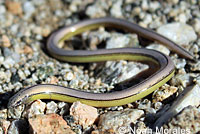 |
 |
 |
 |
| Adult © William Flaxington | Adult © Chad Lane | Adult © Chad Lane | Adult | © William Flaxington The only species of Legless Lizard to have double, dark lateral stripes extending from head to tail. |
The underside is yellow © William Flaxington |
found in the pink area | |
| Bakersfield Legless Lizard Anniella grinnelli |
 |
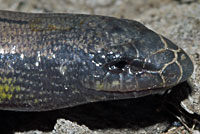 |
 |
 |
 |
 |
 |
| Adult | Adult | Adult | Adult © Ryan Sikola | A black mid-dorsal stripe 1/2 scale wide and lateral black stripes one scale wide are present from head to tail. |
The only species of Legless Lizard with an grayish red or purple underside. | Found in the dark blue area | |
| San Diegan Legless Lizard Anniella stebbinsi |
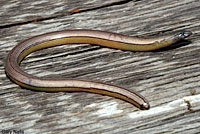 |
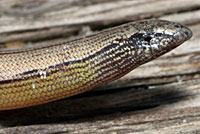 |
 |
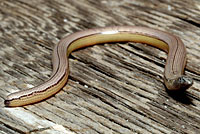 |
 |
 |
 |
| Adult | Adult | Adult © Chad Lane | Adult | A black mid-dorsal stripe less than one scale wide and single lateral black stripes one scale wide are present from head to tail. | The underside is yellow © Adam G. Clause |
Found in the orange areas | |
| Northern Legless Lizard Anniella pulchra |
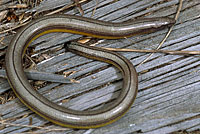 |
 |
 |
 |
 |
 |
 |
| Adult | Adult | Adult © Brad Alexander | Adult © Ryan Sikola | Typically, with a dark line on the back and several dark stripes along the sides, but variations occur. |
The underside is yellow © Robert Maurer Jr. |
Found in the red areas | |
| Black Legless Lizard Anniella pulchra (nigra) (dark phase) |
 |
 |
 |
 |
 |
 |
 |
| Adult | Adult | Adult | Juvenile - silvery in color | This subspecies can be identified by the solid dark color on the back and top of the sides. | The underside is yellow © Chad Lane |
Found in the yellow/black area at the edge of the Monterey Bay | |
Collared Lizards - genus Crotaphytus |
|||||||
 |
Medium-sized, robust, fast-moving diurnal desert lizards, typically seen on top of rocks. The head is large with dark markings around the neck. The tail is long and slightly flattened vertically. The rear legs are large. Adults are almost 4 and a half inches long, not including the tail, or over a foot long including the tail (11.2 cm or 30.5 cm). Color and pattern varies between sexes. Two similar-looking species are found in California: Great Basin Collared Lizard and Baja California Collared Lizard. They are not found in the same areas, so you an use the range maps to identify the species. More About Collared Lizard Identification. |
||||||
| Physical Features to Observe When Identifying a Collard Lizard |
 |
 |
 |
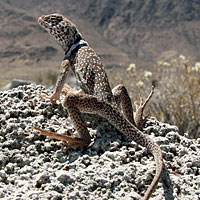 |
 |
||
| Large wide body is about 4.5 inches long (11.4 cm). Males have dark markings on the throat and belly. |
Large head, narrow neck. |
Dark markings around the neck. | Large rear legs. Tail is slightly flattened vertically. Typically seen perched on a rock in the sun. |
Mostly granular scales | |||
| Great Basin Collared Lizard Crotaphytus bicinctores |
 |
 |
 |
 |
 |
 |
 |
| Adult male | Adult male - throat is dark | Adult female | Adult male © Mike Ryan | Adult female red breeding color | Juvenile | Found in the red areas | |
| Baja California Collared Lizard Crotaphytus vestigium |
 |
 |
 |
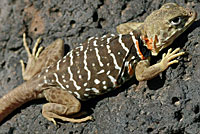 |
 |
 |
 |
| Adult male | Adult female - throat is not dark | Adult female | Adult female with red breeding color | Adult male © Will Wells | Juvenile | Found in the red area | |
Leopard Lizards - genus Gambelia |
|||||||
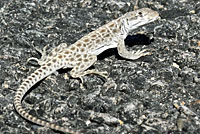 |
A large robust, fast-moving lizard. Found in open dry areas and deserts. Nearly 6 inches long, not including the tail or about 12 inches long if you measure the tail (15.2 cm or 30.5 cm). Three species of Leopard Lizard are found in California but they do not overlap in range except in on tiny area: Cope's Leopard Lizard, Blunt-nosed Leopard Lizard, and Long-nosed Leopard Lizard. Use the range maps to identify the species. More About Leopard Lizard Identification. |
||||||
| Physical Features to Observe When Identifying a Leopard Lizard |
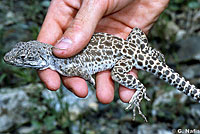 |
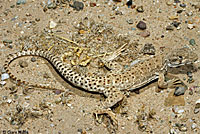 |
 |
 |
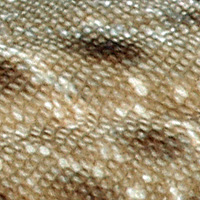 |
||
| Body is about 6 inches long. Tail is about the same. |
Small spots on back in light phase | Large blotches in dark phase © Debbie Frost |
Breeding females have red or orange markings. |
Smooth granular scales on the body | |||
| Cope's Leopard Lizard Gambelia copei |
 |
 |
 |
 |
 |
 |
 |
| Adult female with red breeding color. | Adult female | Adult male © Rob Schell | Adult male © Rob Schell | Adult male © Stuart Young | Underside of breeding female. | Found in the red area | |
| Blunt-nosed Leopard Lizard Gambelia sila |
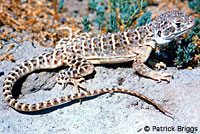 |
 |
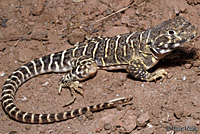 |
 |
 |
 |
 |
| Light phase adult male © Patrick Briggs | Adult male - short nose | Dark phase adult male | Adult female with red breeding color. | Adult © Chad Lane | Hatchling © Jon Hirt | Found in the red area | |
| Long-nosed Leopard Lizard Gambelia wislizenii |
 |
 |
 |
 |
 |
 |
 |
| Adult | Adult - long nose | Adult | Adult female with red breeding color. | Adult female with red breeding color. © Adam Clause |
Juvenile | Found in the red areas | |
Banded Geckos - genus Coleonyx |
|||||||
 |
Small, smooth-skinned nocturnal lizards with large fat tails, usually seen active at night, mostly in desert or open dry areas. Adult body size is 2-3 inches long (5 - 7.6 cm), not including the tail, and 4 to 5 inches long with the tail (10 - 12.7 cm). Two species are found in California, with some overlap in range: Peninsula Banded Gecko, and Western Banded Gecko. They can be separated by size, appearance, and a close look at the skin. The Western Banded Gecko has two subspecies which can mostly be separated by range. There are some other details which can help to identify the subspecies here: Western Banded Gecko ID |
||||||
| Physical Features to Observe When Identifying a Banded Gecko |
 |
 |
 |
 |
 |
 |
 |
| Small body, 2-3 inches long (5 - 7.6 cm). | Tail is fat and constricted at the base. | Triangular head, wider than the neck. |
Moveable eyelids with vertical pupils. | Males have spurs at the base of the tail. Females do not have spurs. | Peninsula Banded Gecko - Smooth skin with small granular scales interspersed with larger tubercles. |
Desert Banded Gecko - Smooth skin with small granular scales but no larger tubercles. |
|
| Peninsula Banded Gecko Coleonyx switaki |
 |
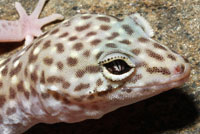 |
 |
 |
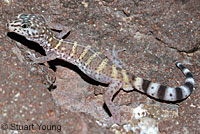 |
 |
 |
| Adult female | Adult female | Adult male | Adult © Bruce Edley | Adult © Stuart Young | Hatchling © Jeff Nordland | Found in the red area | |
| Western Banded Gecko - Coleonyx variegatus - (Two subspecies are found in California) (Identifying Western Banded Gecko Subspecies) |
|||||||
| San Diego Banded Gecko Coleonlyx variegatus abbotti |
 |
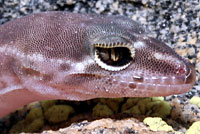 |
 |
 |
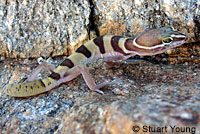 |
 |
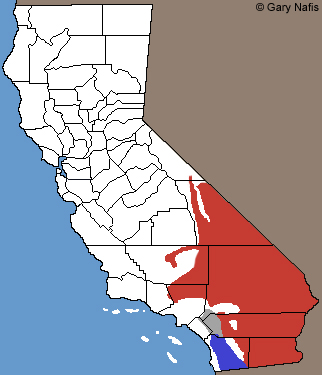 |
| Adult © Stuart Young | Sub-adult | Adult © Nathan Smith | Adult © Stuart Young | Adult | Found in the dark blue area | ||
| Desert Banded Gecko Coleonyx variegatus variegatus |
 |
 |
 |
 |
 |
 |
 |
| Adult | Adult | Adult | Adult | Rare, spotted individual. © Stuart Young |
Juveniles have solid bands | Found in the red area | |
| Leaf-toed Geckos - genus Phyllodactylus |
|||||||
 © Stuart Young © Stuart Young |
Small, smooth-skinned nocturnal lizards limited to rocky desert areas. Adults grow up to 2.5 inches in length (6.35 cm) not including the tail. One species is found in California. Its range overlaps the range of the Desert Banded Gecko, but the two species can be separated by appearance, by the toe tips, and by behavior - this species is a rock-climbing specialist while the Western Banded Gecko is more terrestrial. |
||||||
| Peninsula Leaf-toed Gecko Phyllodactylus nocticolus |
 |
 |
 |
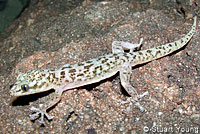 |
 |
 |
 |
| Adult | Large eyes with vertical pupils. | Adult | Adult © Stuart Young | Body is small, up to 2.5 inches long. | Toes have expanded tips | Found in the red area | |
Gila Monsters - genus Heloderma |
|||||||
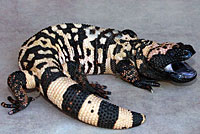 |
Venomous and potentially dangerous. A large thick-bodied lizard with very roughly-textured black and pink skin that appears beaded. Tails is short and fat. Limited to only a few locations in the deserts. Adult body is 9-14 inches long, not including the tail (22.9 - 35.6 cm). One species is found in California but it is very rare in the state. |
||||||
| Gila Monster Heloderma suspectum Banded Gila Monster Heloderma suspectum cinctum |
 |
 |
 |
 |
 |
 |
 |
| Arizona Adult | Arizona Adult | California adult © Andrea Reddick | Large body - up to 14 inches long | Arizona Adult | Nevada Juvenile © Kim Lewis | Found in the red areas | |
Desert Iguanas - genus Dipsosaurus |
|||||||
 |
A large diurnal lizard with a long thick tail and a small head with a blunt nose, a dark and light pattern on the back and tail, and a row of enlarged scales on the middle of the back form a small crest. Found only in the deserts where they often shelter in holes in the ground. Adults are 4 to 5.75 inches long, not including the tail (10 - 14.6 cm). One species is found in California. |
||||||
| Desert Iguana Dipsosaurus dorsalis Northern Desert Iguana Dipsosaurus dorsalis dorsalis |
 |
 |
 |
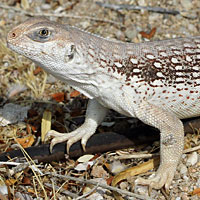 |
 |
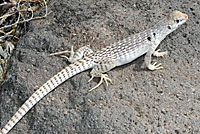 |
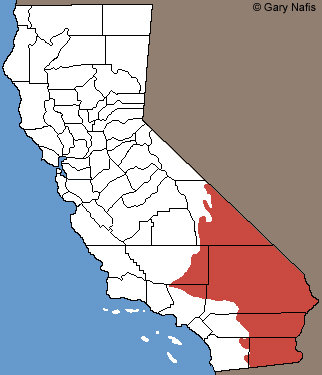 |
| Adult | Adult - notice the slight dorsal crest | Adult | Adult | Body is up to 5.75 inches long |
Juvenile | Found in the red area | |
Chuckwallas - genus Sauromalus |
|||||||
 © Adam Clause © Adam Clause |
A large fat diurnal lizard with loose skin and a wide blunt-tipped tail. Adults are 5 - 9 inches long, not including the tail (12.7 - 22.9 cm). |
||||||
| Common Chuckwalla Sauromalus ater |
 |
 |
 |
 |
 |
 |
 |
| Adult male. Body is large, up to 9 inches long. © Andrew Borcher |
Adult | Adult females retain their juvenile banding pattern © Ryan Sikola | Adult male | Adult male | Juveniles are banded with yellow markings © Jeremiah Easter | Found in the red area | |
Zebra-tailed Lizards - genus Callisaurus
|
|||||||
 |
A pale thin fast-moving diurnal lizard with dark rings around a long thin tail. |
||||||
| Zebra-tailed Lizard Callisaurus draconoides Western Zebra-tailed Lizard Callisaurus draconoides rhodostictus |
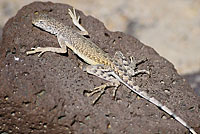 |
 |
 |
 |
 |
 |
 |
| Adult female | Adult - showing fringed eyes and ear opening |
Adult female with breeding colors | Adult male with breeding colors - threat display © David Walton |
Adult male with black bars and colors on underside. © Jackson Shedd |
The black and white striped tail underside is a good identifier |
Found in the red area | |
| Banded Rock Lizards - genus Petrosaurus
|
|||||||
 |
A medium-sized lizard with a black collar around the neck and a long thin tail. |
||||||
Mearns's Rock Lizard Petrosaurus mearnsi Mearns's Rock Lizard Petrosaurus mearnsi mearnsi |
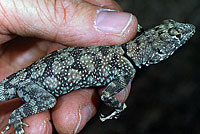 |
 |
 |
 |
 |
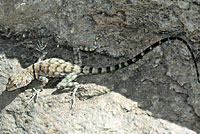 |
 |
| Adult body is 3 - 4.5 inches long | Adult | Adult | Adult female with orange breeding color | Adult © Bruce Edley | Hatchling | Found in the red area | |
Horned Lizards - genus Phrynosoma |
|||||||
 |
A small flat-bodied lizard with a wide oval-shaped body, scattered enlarged pointed scales on the upper body and tail, and large horns on the head, except in the Pygmy Short-horned species. Typically found in open areas with loose soil that the lizards bury themselves in. Adults range from 1.25 inches to 4.5 inches long, depending on the species, not including the tail (3.2 - 11.4 cm). Four species are found in California. Blainville's Horned Lizard, Pygmy Short-horned Lizard, Flat-tailed Horned Lizard, and Desert Horned Lizard, with two subspecies. C The species can easily be identified by looking at the range maps. There is no overlap in range. More About Horned Lizard Identifiation |
||||||
| Physical Features to Observe When Identifying a Horned Lizard |
 |
 |
 |
 |
 |
 |
 |
| Large rounded flat body | Broad head with long horns on three of four species. |
Only the Pygmy Horned Lizard has very small horns |
Blainville's Horned Lizard body is up to 4.5 inches long (11.4 cm) |
The number of rows of fringed scales on the sides can help to differentiate Blainville's Horned Lizard from the Desert Horned Lizard. | The size of the scales on the throat can help to differentiate Blainville's Horned Lizard from the Desert Horned Lizard. | The body of a Horned Lizard is covered with small granular scales interspersed with larger pointed scales | |
| Blainville's (Coast) Horned Lizard Phrynosoma blainvillii |
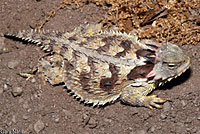 |
 |
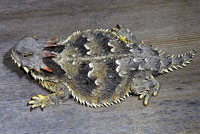 |
 |
 |
 |
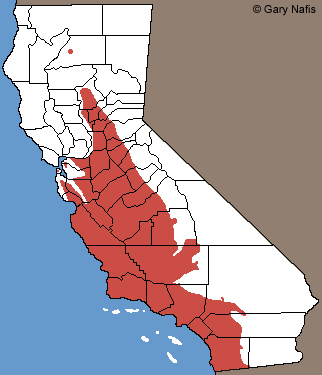 |
| Adult female | Large horns on head | Adult male | Adult © Jackson Shedd | Two rows of fringed scales on the sides. | Juvenile | HIstorically found in the red areas | |
| Pygmy Short-horned Lizard Phrynosoma douglasii |
 |
 |
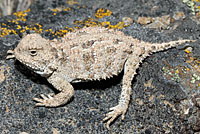 |
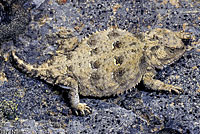 |
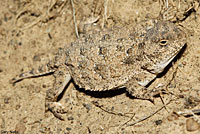 |
 |
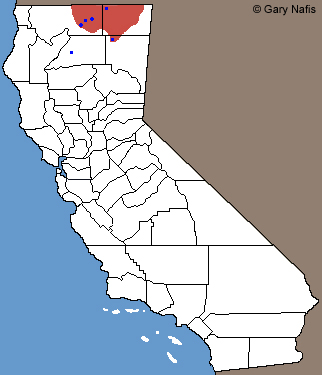 |
| Adult | The horns are small and inconspicuous | Adult | Adult | Adult | Juvenile © James R. Buskirk | Found in the red area | |
| Flat-tailed Horned Lizard Phrynosoma mcallii |
 |
 |
 |
 |
 |
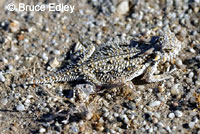 |
 |
| Adult | Large horns on head | Note the large flat tail | Adult | Adult © Patrick Briggs | Juvenile © Bruce Edley | Found in the red area | |
| Desert Horned Lizard - Phrynosoma platyrhinos - (Two subspecies are found in California) |
|||||||
| Southern Desert Horned Lizard Phrynosoma platyrhinos calidiarum |
 |
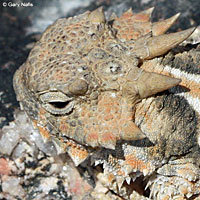 |
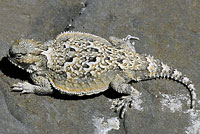 |
 |
 |
 |
 |
| Adult | Large horns on head | Adult | Adult | One row of fringed scales on the sides. | Juvenile | Found in the red area | |
| Northern Desert Horned Lizard Phrynosoma platyrhinos platyrhinos |
 |
 |
 |
 |
 |
 |
 |
| Adult | Large horns on head | Adult © Debra Frost | Adult © Debra Frost | One row of fringed scales on the sides. | Juvenile | Found in the dark blue area | |
Spiny Lizards - genus Sceloporus |
|||||||
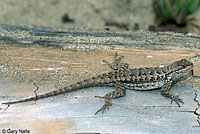 |
These are the common lizards often seen in yards and gardens as well as in undeveloped places. Spiny Lizards are small to large lizards with heads larger than the neck, rounded or slightly flattened bodies, long slender fingers and toes, and keeled scales with sharp spines. Males of most species have patches of blue color on the throat and underside. Commonly called "Blue-bellies" or "Swifts." Color and pattern varies between sexes. Adults of the three large Spiny Lizard species measure from 4.6 - 5.7 inches long, not including the tail (11.7 - 14.2 cm). Adults of the two small species of Spiny Lizards measure up to 3.5 inches long, not including the tail (8.9 cm). Five species are found in California: Desert Spiny Lizard, Yellow-backed Spiny Lizard, Common Sagebrush Lizard (with 3 subspecies), and Western Fence Lizard (with six subspecies). |
||||||
| Physical Features to Observe When Identifying a Spiny Lizard |
 |
© Bo Zaremba |
 |
 |
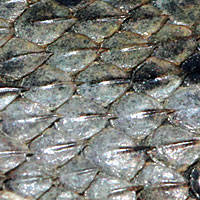 |
 |
|
| Spiny Lizards are good climbers, typically seen on walls, fences, trees, and rocks. | Spiny lizards have large overlapping scales on the back with sharp spines on them. These spines are not always apparent when seen from a distance. | ||||||
| Desert Spiny Lizard Sceloporus magister |
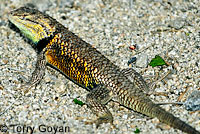 |
 |
 |
 |
 |
 |
 |
| Adult male. This is a large species of Spiny Lizard, growing up to 5.7 inches long, not including the tail (14.2 cm). © Terry Goyan |
Adult male | Adult female | Adult male in defensive stance © Steve Sumioka |
Adult female with red breeding color on head © Jim Brock | Juvenile | Found in the red area | |
| Granite Spiny Lizard Sceloporus orcutti |
 |
 |
 |
 |
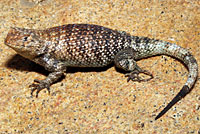 |
 |
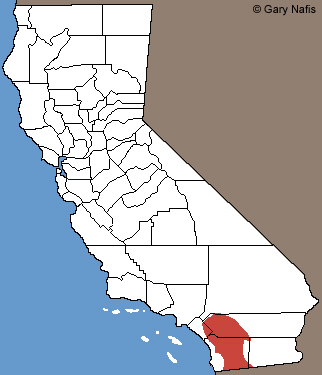 |
| Adult male. Males can show bright blue-green colors and purple on the back. This is a large species of Spiny Lizard, growing up to 4.6 inches long, not including the tail (11.7 cm). © Jason Jones |
Adult female | Adult male - note purple patch on back © Amber Carson |
Adult female - the pattern is more banded than on males |
Adult female | Juvenile - note the more distinct banded pattern © Marisue Crystal | Found in the red area | |
| Yellow-backed Spiny Lizard Sceloporus uniformis |
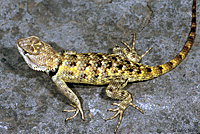 |
 |
 |
 |
 |
 |
 |
| Adult female. This is a large species of Spiny Lizard, growing up to 5.7 inches long, not including the tail (14.2 cm). | Adult female | Adult female | Adult male defensive display © Steve Bledsoe |
Adult male © Patrick Briggs | Juvenile | Found in the red areas | |
Comparison of Western Fence Lizards and Common Sagebrush Lizards |
|||||||
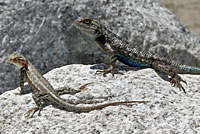 |
Western Fence Lizards are the lizard most people are likely to see in California as they are common and abundant in populated areas as well as in natural areas. Common Sagebrush lizards are typically found at higher elevations in less-populated areas than Western Fence Lizards, but in some places sagebrush lizards occur with fence lizards and this can make identification difficult since both species look similar and most adults are a similar size. Adults of both species grow up to 3.5 inches long, not including the tail (8.9 cm). Below are some characteristics that can help to tell the two species apart. Here is more information about comparing fence lizards with sagebrush lizards |
||||||
| Left - female Common Sagebrush Lizard Right - male Western Fence Lizard |
|||||||
| Physical Features to Observe When Identifying a Common Sagebrush Lizard |
 |
 |
 |
 |
 |
||
| A black bar on the shoulder | Rusty coloring in the armpits | Small granular scales on the rear of the thighs. No yellow/orange coloring underneath. |
Adult males have blue under the throat and on the sides of the belly. | The Common Sagebrush Lizard (Left) has smaller keeled scales on the back than the Western Fence Lizard (Right). © Patrick Briggs |
|||
| Physical Features to Observe When Identifying a Western Fence Lizard |
 |
 |
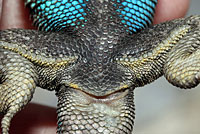 |
 |
 |
||
| No black bar on the shoulder | No rusty coloring in the armpits | Llarger keeled scales on the rear of the thighs. Yellow/orange coloring underneath, |
Adult males have blue under the throat and on the sides of the belly. | The Western Fence Lizard (Right) has larger keeled scales on the back than the Common Sagebrush Lizard (Left). © Patrick Briggs |
|||
| Common Sagebrush Lizard - Sceloporus graciosus - (Three subspecies are found in California) |
|||||||
| Western Sagebrush Lizard Sceloporus graciosus gracilis |
 |
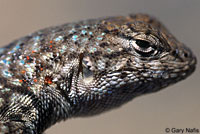 |
 |
 |
 |
 |
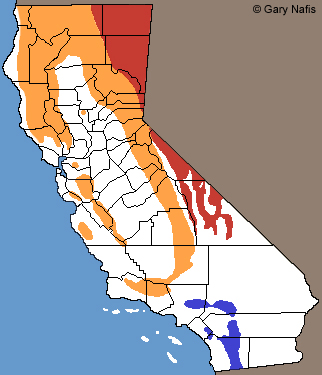 |
| Adult female | Adult male | Adult male | Adult male | Adult female | Juvenile | Found in the orange areas | |
| Northern Sagebrush Lizard Sceloporus graciosus graciosus |
 |
 |
 |
 |
 |
 |
 |
| Adult female | Adult male | Adult male | Adult female | Adult male | Juvenile | Found in the red areas | |
| Southern Sagebrush Lizard Sceloporus graciosus vandenburgianus |
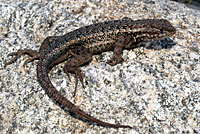 |
 |
 |
 |
 |
 |
 |
| Adult male | Adult female | Adult female | Adult female | Adult male | Adult female with orange breeding color. © Scott Shoemaker |
Found in the dark blue areas | |
| Western Fence Lizard - Sceloporus occidentalis - (Six subspecies are found in California)
|
|||||||
| Island Fence Lizard Sceloporus occidentalis becki |
 |
 |
 |
 |
 |
 |
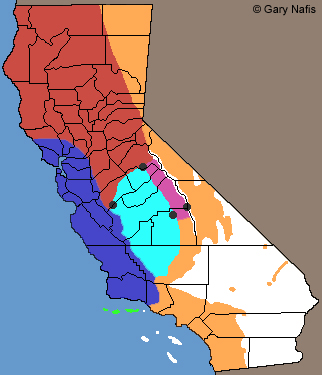 |
| Adult male. This subpecies (maybe a full species) is found only on the northern Channel Islands. | Adult male | Adult male | Adult male | Adult male | Juvenile, Santa Cruz Island | Found in the bright green areas | |
| San Joaquin Fence Lizard Sceloporus occidentalis biseriatus |
 |
 |
 |
 |
 |
 |
 |
| Adult male. This subspecies is found mostly in the southern Central Valley | Adult male © Patrick Briggs | Adult female | Adult male © Patrick Briggs | Adult male, front Adult female, back |
Juvenile | Found in the bright blue area | |
| Coast Range Fence Lizard Sceloporus occidentalis bocourtii |
 |
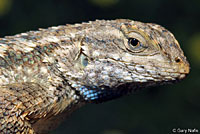 |
 |
 |
 |
 |
 |
| Adult female. This subspecies is found in the coastal region from Sonoma County to Ventura County. |
Adult male | Adult male | Adult female | Adult male | Juvenile | Found in the dark blue area | |
| Great Basin Fence Lizard Sceloporus occidentalis longipes |
 |
 |
 |
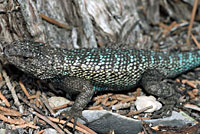 |
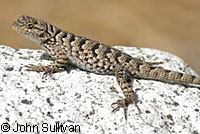 |
 |
 |
| Adult male. This subspecies is found in coastal Southern California, the southern Sierra Nevada, and the desert regions. | Adult male | Adult male | Adult male | Adult female © John Sullivan | Juvenile |
Found in the orange areas | |
| Northwestern Fence Lizard Sceloporus occidentalis occidentalis |
 |
 |
 |
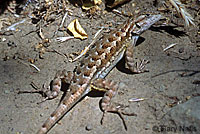 |
 |
 |
 |
| Adult male. This subspecies is found in much of northern California. | Adult male | Adult male | Adult female | Adult female | Juvenile | Found in the red area | |
| Sierra Fence Lizard Sceloporus occidentalis taylori |
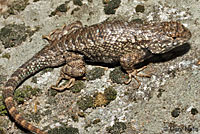 |
 |
 |
 |
 |
 |
 |
| Adult. This subspecies is found only at high elevations in the central Sierra Nevada mountains. | Adult | Adult | Adult male | Adult female | Males have bright blue coloring underneath © Patrick Briggs | Found in the violet area | |
Fringe-toed Lizards - genus Uma |
|||||||
 |
A flat-bodied, smooth-skinned lizard that only inhabits desert areas of loose wind-blown sand. Approximately 5 inches long, not including the tail, and almost 10 inches long including the tail (12.7 - 25.4 cm). Three species are found in California: Coachella Fringe-toed Lizard, Colorado Desert Fringe-toed Lizard, and Mohave Fringe-toed Lizard. There is no overlap in range, so you can use the range maps to identify the species. More information about Fringe-toed Lizard Identification |
||||||
| Physical Features to Observe When Identifying a Fringe-toed Lizard |
 |
 |
 |
 |
 |
 |
|
| Wide flat pale body, with a pattern of fine brown and black markings. | Pattern helps a lizard to blend into its background of loose sand. | Fringes on toes of rear foot to keep them from sinking into fine wind-blown sand. |
Typically seen basking on wind-blown sand dunes, running away quickly and often diving into the sand to hide. | Smooth skin with granular scales. | |||
| Coachella Fringe-toed Lizard Uma inornata |
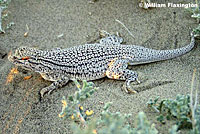 |
 |
 |
 |
 |
 |
 |
| Adult. This species is found only in the Coachella Valley. © William Flaxington | Adult male | Adult | Adult male | Adult © Bon Terra Consulting | Adult male | Found in the red area | |
| Colorado Desert Fringe-toed Lizard Uma notata |
 |
 |
 |
 |
 |
 |
 |
| Adult male. This species is found only in the Sonoran Desert in Imperial and San Diego Counties. | Adult male | Adult male | Adult male © Patrick Briggs | Adult male | Adult male | Found in the red areas | |
| Mohave Fringe-toed Lizard Uma scoparia |
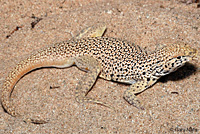 |
 |
 |
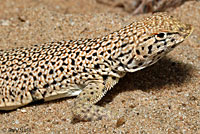 |
 |
 |
 |
| Adult male. This species is found only in the Mojave Desert. | Adult male | Adult © Zachary Cava | Adult male | Adult | Adult male | Found in the red area | |
Tree and Brush Lizards - genus Urosaurus |
|||||||
 |
Small, slim-bodied climbing lizards, similar to Spiny Lizards but without the spiny scales and with a fold on the throat. Found mostly in the deserts. As their name indicates, they are usually seen on trees and in brush, but they can often be seen in brushy areas basking on rocks. Three species are found in California: Long-tailed Brush Lizard, Small-scaled Lizard, and Ornate Tree Lizard. They can be difficult to tell apart, but the location can help in most cases. You might need to get a close-up look and observe the scales in the middle of the back on lizards near the Colorado River. They are most likely to be confused with Side-blotched lizards as they are similar in size and occur in similar habitat. Tree and Brush Lizard Species Identification |
||||||
| Long-tailed Brush Lizard Urosaurus graciosus Western Long-tailed Brush Lizard Urosaurus graciosus graciosus |
 |
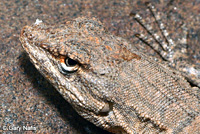 |
 |
 |
 |
 |
 |
| Adult, Adults get up to 2.6 inches long, (6.6 cm) not including the tail, which can be more than 5 inches long (12.7 cm). | Adult male | Adult female | Adult male underside | Adult with very long unbroken tail | Wide band of enlarged weekly-keeled scales on the back is not split in the center by a band of smaller scales. | Found in the red areas | |
| Small-scaled Lizard (Black-tailed Brush Lizard) Urosaurus microscutatus |
 |
 |
 |
 |
 |
 |
 |
| Adult female. Adults get up to 1.5 inches long, not including the tail (5.1 cm). | Adult female | Adult female | Adult male display, showing orange under throat and blue on belly. | Adult male, with black tail | A band of slightly-enlarged scales on the middle of the back are not split in the center by a band of smaller scales. |
Found in the red area | |
| Ornate Tree Lizard Urosaurus ornatus Colorado River Tree Lizard Urosaurus ornatus symmetricus |
 |
 |
 |
 |
 |
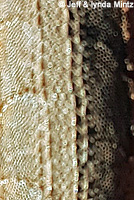 |
 |
| Adult. Adults grow up to 2.25 inches long (5.7 cm), not including the tail, which can be about 4 inches long (10.2 cm). | Adult female | Adult female | Adult © Jeff & lynda Mintz | Adult © William Flaxington | Wide scales on the back are split in the center by a large band of smaller scales. | Found in the red areas | |
Common Side-blotched Lizard - Uta stansburiana - (Two subspecies in California) |
|||||||
 |
A very small smooth-skinned lizard typically with a dark spot behind the front legs. Most common in open dry areas. Not common in suburban yards outside of the deserts. Color and pattern varies between sexes. Males often with blue on the back and bright orange or yellow on the throat - colors not always apparent when seen at a distance. Females are less colorful with a more defined pattern on the back, sometimes with chevrons or light stripes. Adults are 1.5 - 2.5 inches long, not including the tail (3.8 - 6.3 cm). Two subspecies of Common Side-blotched Lizards are found in California. They are very similar in appearance, but the Nevada Side-blotched Lizard usually has a more reduced, often uniform pattern consisting of mostly scattered light and dark spotting. The best thing to do is check the range map to find out which one is in your area. The only area where there may be some confusion is in the Owens Valley where the two subspecies come into contact. |
||||||
| Physical Features to Observe When Identifying a Side-blotched Lizard |
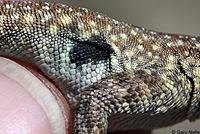 |
 |
 |
 |
 |
 |
 |
| The "side blotch" - a dark mark on the sides behind the front legs that gives this species its common name, is more well-defined on males. | Fold around the throat - not found on fence lizards or sagebrush lizards. | Male throat color varies - yellow, blue, or orange. | Males have blue marks on the back and sometimes bright orange and yellow on the sides. | Small keeled scales on the back without spines. |
|||
| Western Side-blotched Lizard Uta stansburiana elegans |
 |
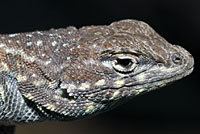 |
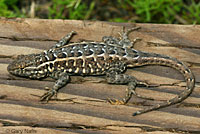 |
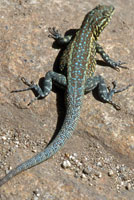 |
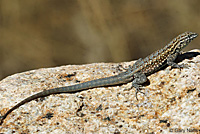 |
 |
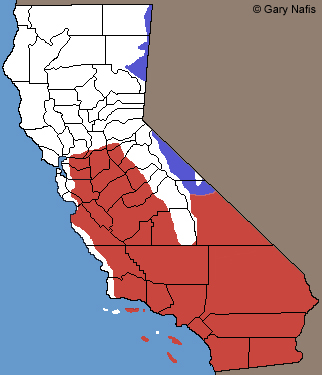 |
| Adult male | Adult female | Adult female | Adult male | Adult female | Juvenile © Patrick Randall | Found in the red areas | |
| Nevada Side-blotched Lizard Uta stansburiana nevadensis |
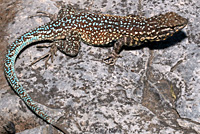 |
 |
 |
 |
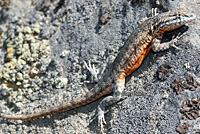 |
 |
 |
| Adult male This subspecies has mostly scattered light and dark spotting. |
Adult male | Adult male | Adult male | Adult with orange breeding color | Juvenile | Found in the dark blue areas | |
Toothy Skinks - genus Plestiodon |
|||||||
 |
Skinks are small to medium-sized lizards with smooth shiny skin, small legs compared to other lizard species, and a long tapered tail that is sometimes blue or reddish. Juveniles are similar to adults with a blue or pink tail. Juvenile Gilbert's Skinks also tend to have a striped pattern which fades on adults. Found in a wide variety of habitats in most of the state excluding the deserts. Two native species of skinks are found in California - the Western Skink, with two subspecies, and Gilbert's Skink, with four subspecies. There is some overlap in range. Western Skinks grow up to 3.4 inches (8.6 cm) in length, not including the tail. Gilbert's Skinks are larger - up to 4.5 inches (11.4 cm) in length, not including the tail. More Information on Identifying California Skinks |
||||||
Gilbert's Skink - Plestiodon gilberti - (Four subspecies in California) |
|||||||
| Physical Features to Observe When Identifying a Gilbert's Skink |
 |
 |
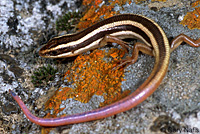 |
 |
 |
 |
|
| Adult Gilbert's Skinks are brownish in color. Some adults retain some of their juvenile stripes. Body size is up to 4.5 inches in length (11.4 cm), without the tail. | Juvenile Gilbert's Skinks have well-defined stripes and a blue or pink tail. | During the breeding season, adult males develop reddish coloring on the head and tail. | Body is covered with mooth shiny scales |
||||
| Variegated Skink Plestiodon gilberti cancellosus |
 |
 |
 |
 |
 |
 |
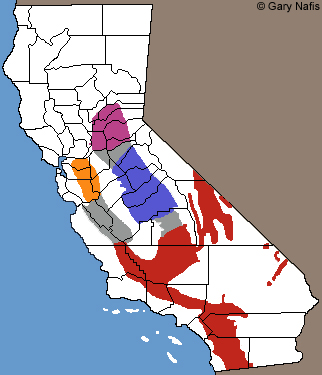 |
| Adult | Adult | © Zach Lim Adult. Some adults retain the juvenile stripes. |
Adult | This subspecies has dark markings around the scales on the back which make it "variegated." | Juveniles have dark and light stripes. | Found in the orange area | |
| Greater Brown Skink Plestiodon gilberti gilberti |
 |
 |
 |
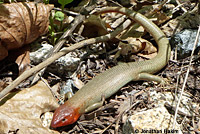 |
 |
 |
 |
| Adult | Adult | Adult male with red breeding color. | © Jonathan Hakim Adult male with red breeding color. |
Adult | Juvenile with stripes and blue tail. | Found in the dark blue area | |
| Northern Brown Skink Plestiodon gilberti placerensis |
 |
 |
 |
 |
 |
 |
 |
| Adult male with red breeding color. | Adult © Joshua L. Puhn | Adult © William Flaxington |
Sub-adult | © Connor Long Juvenile with stripes and blue tail |
Found in the purple area | ||
| Western Red-tailed Skink Plestiodon gilberti rubricaudatus |
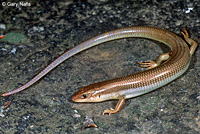 |
 |
 |
 |
 |
 |
 |
| Adult | Adult | Breeding adult male © Patrick Briggs | Adult | Adult | Juvenile with stripes and pink tail | Found in the red areas | |
| Western Skink - Plestiodon skiltonianus - (Two subspecies in California) |
|||||||
| Physical Features to Observe When Identifying a Western Skink |
 |
 |
 |
 |
 |
 |
|
| Adult Western Skinks have light and dark stripes on a brown body. The tail can be blue or brown. |
During the breeding season, adult males develop reddish coloring on the head and tail. | © Brandon Hunsberger Adult body size is fairly small - up to 3.4 inches (8.6 cm) in length, not including the tail. |
Juveniles have distinct stripes and bright blue tails |
Body is covered with smooth shiny scales |
|||
| Coronado Skink Plestiodon skiltonianus interparietalis |
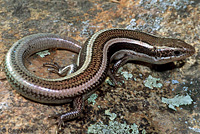 |
 |
 |
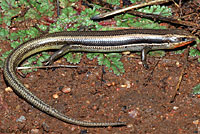 |
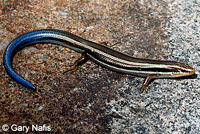 |
 |
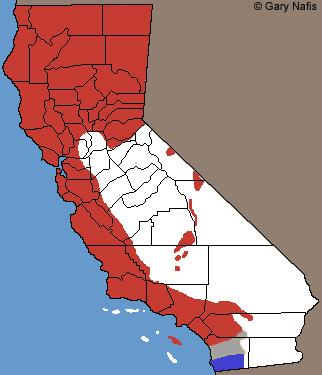 |
| Adult | Adult with breeding orange color | Adult | Adult | Adult | Juvenile © Sean Kelly | Found in the dark purple area | |
| Skilton's Skink Plestiodon skiltonianus skiltonianus |
 |
 |
 |
 |
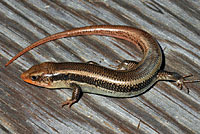 |
 |
 |
| Adult | Adult male with breeding orange color | Adult | Adult | Adult | Juvenile | Found in the red areas | |
Whiptails - genus Aspidoscelis |
|||||||
 |
Whiptails are slim-bodied lizards with a very long slender tail, a pointed snout, and large scales on the head. Scales on the back are small and granular. Active during daylight, and often seen actively moving on the ground in open, dry areas, foraging for insects around vegetation. Occasionally seen climbing on low plants. They are difficult to get close to and are capable of rapid bursts of speed. Two species of Whiptails are native to California, Belding's Orange-throated Whiptail and the Western Whiptail, which has three subspecies. There is also a non-native species that has become introduced into Southern California, so far mostly in Orange County, which can be confused with Belding's Orange-throated whiptail. (See Sonoran Spotted Whiptail, below.) More information about Identifying Whiptails in California. |
||||||
| Physical Features to Observe When Identifying a Whiptail |
 |
 |
 |
 |
 |
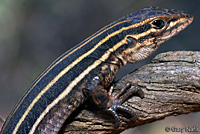 |
 |
| Long body with long thin tail. | Long head with pointed nose | Strongly-marked pattern on the back is marbled, spotted, or striped in appearance. | Small granular scales on the back | ||||
Orange-throated Whiptail
Aspidoscelis hyperythra Belding's Orange-throated Whiptail Aspidoscelis hyperythra beldingi |
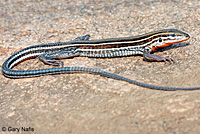 |
 |
 |
 |
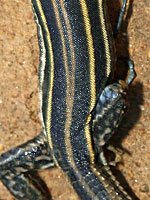 |
 |
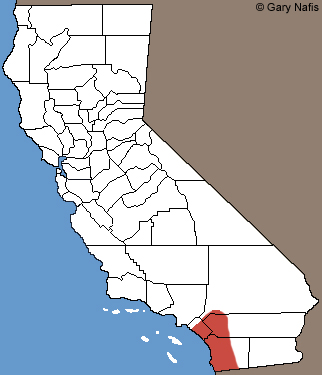 |
| Adult male This species has light stripes on the back, unlike the Western Whiptail. Found only in coastal Southern California. |
Adult female Orange coloring is not always present on this species. |
Adult males have bright orange coloring on the throat, which becomes brighter during the spring breeding season. | Adult male showing orange throat. Smaller than the Western Whiptail. Adults grow up to 2.75 inches (7 cm) in length, not including the tail, which can be more than twice the body length. |
The paravertebral stripes (the two stripes on either side of the middle of the back) merge together on the back and become a single mid-dorsal stripe that extends onto the tail. (Compare with the paravertebral stripes on the Sonoran Whiptail, which remain parallel on the back and fade out on the tail) |
© Darren Ramsey Juveniles have a blue tail. Some adults also retain some of the juvenile blue coloring on the tail. |
Found in the red area | |
| Tiger Whiptail - Aspidoscelis tigris - (Three subspecies in California) |
|||||||
 |
The back of this species is mostly a mottled or marbled pattern, sometimes light or dark markings form irregular stripes. Juveniles tend to have a more striped appearance than adults. Adults grow up to 5 inches long (12.7 cm) not including the tail, or about 13 inches (33 cm) including the tail. Common in the deserts, less common in open dry fields and grasslands in much of the rest of the state. |
||||||
| San Diegan Tiger Whiptail Aspidoscelis tigris stejnegeri |
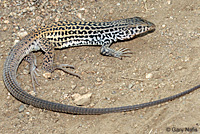 |
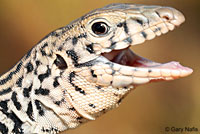 |
 |
 |
 |
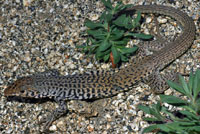 |
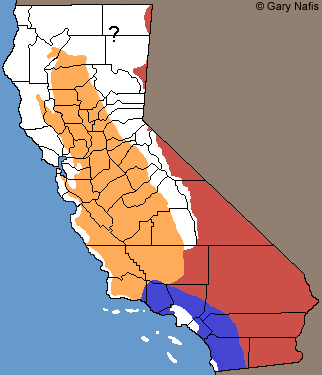 |
| Adult. This subspecies is found in coastal Southern California. | Adult | Adult | Adult © Stacey Bergman | Adult © Jay Keller | Adult | Found in the dark blue area | |
| California Whiptail Aspidoscelis tigris munda |
 |
 |
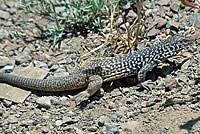 |
 |
 |
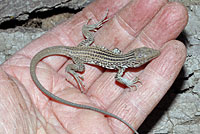 |
 |
| Adult © Jackson Shedd This subspecies is found in the Central Valley and the South Coast Ranges. |
Adult © Patrick Briggs | Adult | Adult © Joel A. Germond | Adult © George Chrisman | Juvenile | Found in the orange area | |
| Great Basin Whiptail Aspidoscelis tigris tigris |
 |
 |
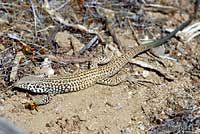 |
 |
 |
 |
 |
| Adult © Adam Clause This subspecies is found in the deserts. |
Adult | Adult |
Adult © Adam Clause | Adult | Juvenile | Found in the red areas | |
| Night Lizards - genus Xantusia
|
|||||||
 |
Night Lizards are small, thin, soft-skinned lizards with large eyes with vertical pupils (for seeing at night and in dark places). Color and pattern and behavior are variable, depending on the species. Six species are found in California, with only a small area where ranges overlap - Sandstone Night Lizard, Granite Night Lizard, Sierra Night Lizard, Desert Night Lizard, Wiggins' Night Lizard, and Island Night Lizard. Adults of most species grow to about 2.75 inches in length (7 cm) not including the tail. Wiggin's Night Lizard is smaller, at 1.7 inches long from snout to vent (4.4 cm). The Island Night Lizard is much larger, up to 4.2 inches long (10.6 cm). |
||||||
| Physical Features to Observe When Identifying a Night Lizard |
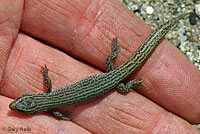 |
 |
 |
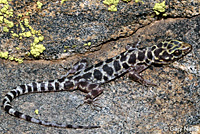 |
 |
||
| Small lizards with a long tail, either speckled or mottled in appearance, depending on the species. Some species have a dark phase, seen when a lizard is hiding in a dark place, and a light phase, seen when a lizard is active on light-colored rocks. | Pupils are vertical | Adult - dark phase | Adult - light phase | ||||
| Sandstone Night Lizard Xantusia gracilis |
 |
 |
 |
 |
 |
 |
|
| Adults are about 2.75 inches in length (7 cm) not including the tail. |
Adult | Adult | Adult | Adult | Adult | Found in the red dot | |
| Granite Night Lizard Xantusia henshawi |
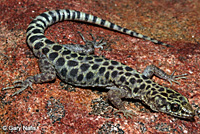 |
 |
 |
 |
 |
 |
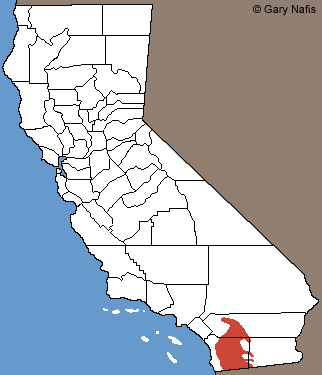 |
| Adults are about 2.75 inches in length (7 cm) not including the tail. |
Adult | Adult - dark phase | Adult - light phase | Adult | Adult and juvenile | Found in the red area | |
| Sierra Night Lizard Xantusia sierrae |
 |
 |
 |
 |
 |
 |
 |
| Adults are about 2.75 inches in length (7 cm) not including the tail. |
Adult | Adult © Tim Burkhardt | Adult © Jackson Shedd | Adult | Found in the dark blue area | ||
| Desert Night Lizard Xantusia vigilis |
 |
 |
 |
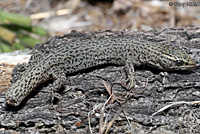 |
 |
 |
 |
| Adults are about 2.75 inches in length (7 cm) not including the tail. |
Adult | Adult | Adult, missing the end of its tail | Adult | Juvenile, missing the end of its tail | Found in the red area | |
| Wiggins' Night Lizard Xantusia wigginsi |
 |
 |
 |
 |
 |
 |
 |
| Adults are about 1.7 inches long (4.4 cm) not including the tail. |
Adult | Adult | Adult | Adult | Juvenile | Found in the red areas | |
| Island Night Lizard - Xantusia riversiana - (Two subspecies in California) |
|||||||
| San Clemente Night Lizard Xantusia riversiana reticulata |
 |
 |
 |
 |
 |
 |
 |
| Adults are about 4.2 inches long (10.6 cm) not including the tail. |
Adult | Adult | Striped adult © Bob Haase | Adult | Adult © Bob Haase | Found on the red islands | |
| San Nicolas Night Lizard Xantusia riversiana riversiana |
 |
 |
 |
 |
 |
 |
|
| Adults are about 4.2 inches long (10.6 cm) not including the tail. © Stephanie Root |
Adult © Stephanie Root | Adult © Stephanie Root | Adult © Stephanie Root | Juvenile © Stephanie Root | Found on the bright green island | ||
Established Non-Native Lizards |
|||||||
Anoles - genus Anolis |
|||||||
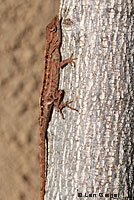 © Len Geiger |
Anoles are small thin lizards with a long pointed snout and a long thin tail. They are excellent climbers, often seen on trees, fences, and shrubs. They will often move to the other side of a tree if you approach them or quickly leap to another perching site nearby. Two non-native species have become established in coastal southern California. Both are similar in size and similar in appearance when brown in color, but there are some details that can help tell them apart. The Green Anole can change color from green to brown, but the Brown Anole cannot change to green. If you see a bright green anole, it's a Green Anole. The color of the dewlap (a colorful pouch below the throat of a male anole) can also help separate the two species. Green Anole males have a pink dewlap, Brown Anole males have an orange dewlap. So far, Green Anoles are the only small mostly-green lizards established in many places in California. Juvenile Iguanas are also bright green, but they are much larger and so far they have not become established in California. Italian Wall Lizards can have patches of green coloring, but they are larger and only in a couple of locations. Jackson's Chameleons can also have green coloring, but they are much larger with a different body shape and they are much less common and much less conspicuous in the few places they have become established. Two species of Anoles are well-established in California - The Green Anole, and the Brown Anole. |
||||||
| Physical Features to Observe When Identifying an Anole |
 |
 |
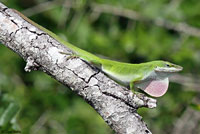 |
 |
 |
 |
|
| Long nose | Brightly-colored dewlap (no other type of lizard in California has them.) | © Chris DeGroof The Green Anole is the only small all-green lizard in the state. |
Small size, smooth skin, brownish or green in color © Charlie Wheeler |
Small granular scales on the back unlike the much larger and spinier scales on the back of the native Fence Lizards that share their habitat. | |||
| Green Anole Anolis Carolinensis |
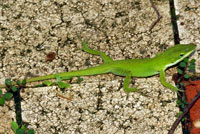 |
 |
 |
 |
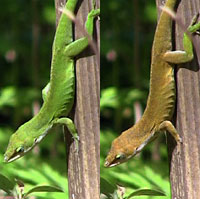 |
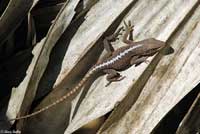 |
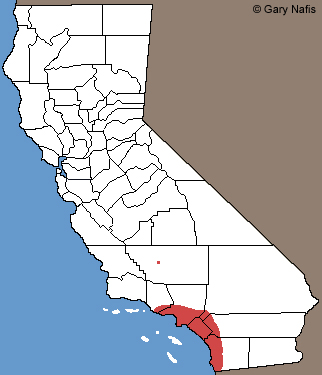 |
| Adult - green phase Adults are bout 3 inches (7.6 cm) long from snout to vent, or 5-8 inches long (12.7 - 20.3 cm) including the tail. |
Adult male - brown phase | Adult - brown phase | Male Green Anoles often display a pink dewlap or pouch on the throat, expanding and contracting it repeatedly to make it appear like a flash of color. | A Green Anole can quickly change its color from green to brown, as you can see in these before and after pictures of the same lizard. Click the picture to watch a short video of the color change. | Sometimes there is a light stripe on the back in either color phase |
Black dots show some of the areas where this lizard has been introduced. So far it is mostly found in the coastal southern California region. | |
| Brown Anole Anolis sagrei |
 |
 |
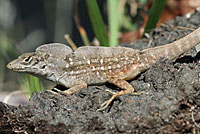 |
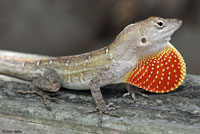 |
 |
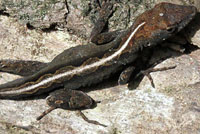 |
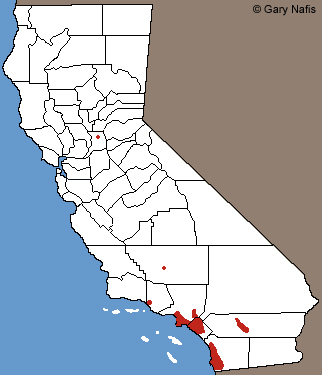 |
| Adult Adults are about 2.5 inches (6.5 cm) long, not including the tail, and about 8 inches long (20.3 cm) including the tail. |
Adult male © Len Geiger | Adult male, displaying the crest on his back |
Male Brown Anoles often display an orange dewlap or pouch on the throat, expanding and contracting it repeatedly to make it appear like a flash of color. | Adult female - Brown Anoles can change from dark brown to pale brown | Females can have a light stripe on back | Black dots show some of the areas where this lizard has been introduced. So far it is mostly found in the coastal southern California region. | |
Established Non-native Geckos - Family Gekkonidae |
|||||||
House Geckos - genus - Hemidactylus |
|||||||
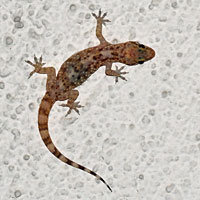 |
House Geckos are small, slightly-flattened nocturnal climbing lizards. Their toes are specialized to enable them to climb smooth surfaces, including glass. Adults of the three species range from about 2.4 to 5 inches long, not including the tail (4.4 - 12.7 cm). With the tail they can be 4 to about 8 inches long (10.2 - 20.3 cm). They have adapted well to living in and around human dwellings in urban, suburban, and rural areas. They have spread largely by being transported in shipments of goods carried in vehicles. As their name suggests, they're typically seen on the walls of houses, especially at night where they like to sit under an external light and wait for flying insects that are attracted to the light. Then they will jump into the air to catch an insect. They can also be found on fences, wood piles, and on and underneath other things around a house. So far, three species of House Gecko are established in California. The most common and widespread is the Mediterranean Gecko. The Indo-Pacific or Fox Gecko and the Tropical House Gecko are so far only found in coastal Southern California. |
||||||
| Physical Features to Observe When Identifying a House Gecko |
 |
 |
 |
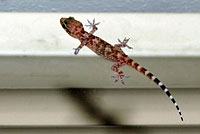 |
 |
 |
 |
| Adults are small - from 2.4 to 5 inches long (4.4.- 20.3 cm), not including the tail. © Nathan Smith | Active at night. Often seen climbing on walls, especially under lights |
Specialized pads under the toes enable House Geckos to climb smooth vertical surfaces, including glass. | Sometimes seen in groups | Pupils are vertical for night vision | |||
| Indo-Pacific Gecko (Fox Gecko, Garnot's House Gecko) Hemidactylus garnotii |
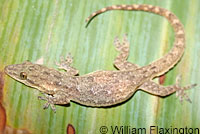 |
 |
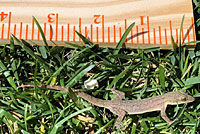 |
 |
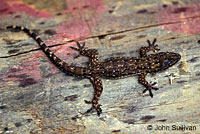 |
 |
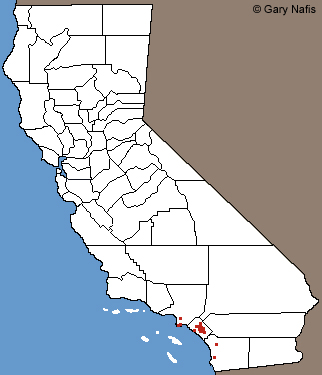 |
| Light phase adult © William Flaxington The skin is smooth with a row of enlarged, spine-like scales along the lateral edge of the tail. |
Long fox-like snout | Adults are about 2.5 inches long (6.4 cm) not including the tail and 4 - 5.5 inches in length (10 - 14 cm) including the tail. | Adult | Adult in dark phase © John Sullivan | Underside is usually yellow and the underside of the tail is red. | Red dots show some of the areas where this lizard has been introduced |
|
| Tropical House Gecko (Wood Slave, etc.) Hemidactylus mabouia |
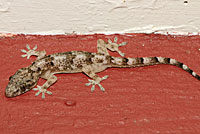 |
 |
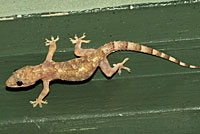 |
 |
 |
 |
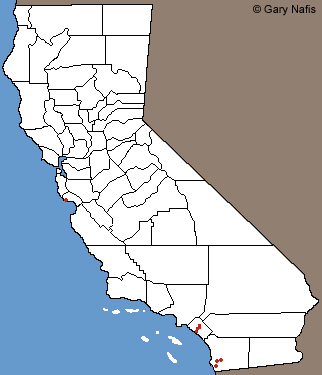 |
| Occurs in a light and dark phase. This adult is in the dark phase. This species can be identified by the four or five rear-facing dark chevron-like markings on the back. |
Adult The skin is covered with small tubercles. |
This is the largest House Gecko found in California. Adults are 4-5 inches (10-12.7 cm) in length, not including the tail, and up to about 8 inchds long with the tail. | Adult © William Flaxington | Adult in light phase © Daniel |
Juvenile in light phase | Red dots show some of the areas where this lizard has been introduced |
|
| Mediterranean Gecko Hemidactylus turcicus |
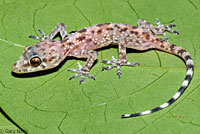 |
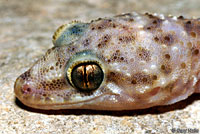 |
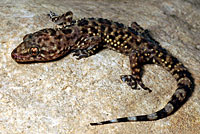 |
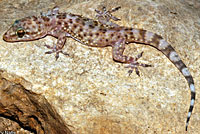 |
 |
 |
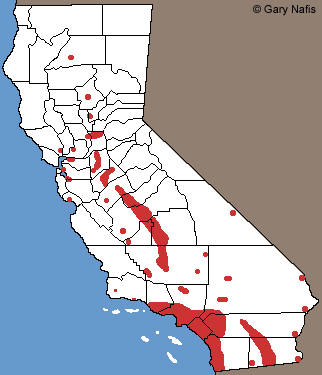 |
| Adults are 1.75 to 2.38 inches long from snout to vent (4.4 - 6 cm) or 4 - 5 inches long including tail (10.2 - 12.7 cm). | Adult The skin is covered with conspicuous large bumpy tubercles. |
These geckos have a light phase and a dark phase. These are pictures of the same lizard in dark phase (left) and light phase (right). |
Adult | Juveniles have more prominent light and dark tail banding than adults. |
Black dots show some of the areas where this lizard has been introduced | ||
Wall Geckos - genus Tarentola |
|||||||
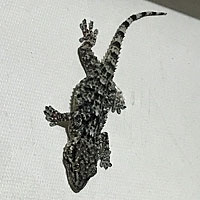 |
Wall Geckos are robust-bodied climbing lizards with large eyes with vertical pupils and no eyelids, elongated toe pads. and rows of large tubercles covering the back. They are larger than the House Geckos and larger than the more common Mediterranean Geckos, which are the only non-native geckos in California so far that have lots of large tubercles on the skin. Wall Geckos are active at night, but are sometimes seen active in daylight. As their name suggests, they are typically seen climbing vertical surfaces such as walls and fences, and they are comfortable living in and around human dwellings. They are spreading more slowly around the state than the House Geckos. Their initial introduction appears to be from the release of pet lizards into the wild rather than from transportation in vehicles. Two species have been introduced into California, the Moorish Gecko and the Ringed Wall Gecko (also called the White-spotted Wall Gecko.) |
||||||
| Physical Features to Observe When Identifying a Wall Gecko |
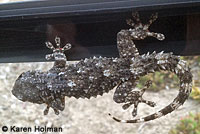 |
 |
 |
||||
| Wall Geckos are larger than House Geckos and the more common Mediterranean Geckos. | Wall Geckos have small granular scales with intermittent large tubercles which give the skin a spiky appearance. They have more tubercles and larger tubercles on the skin than the more common Mediterranean Geckos. |
Specialized toes make it capable of climbing smooth vertical surfaces, including glass. | |||||
| Ringed Wall Gecko (White-spotted Wall Gecko) Tarentola annularis |
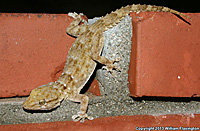 |
 |
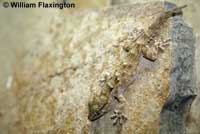 |
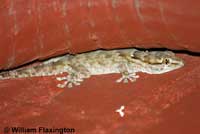 |
 |
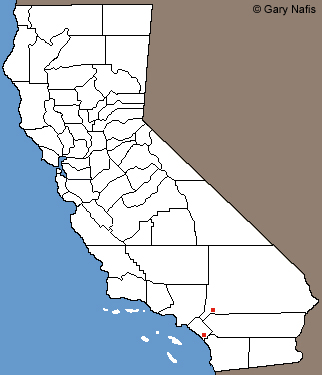 |
|
| Adult © William Flaxington The Ringed Wall Gecko gets up to 8 inches long including the tail (20.3 cm) which is larger than the Moorish Gecko. |
Adult | Adult © William Flaxington This gecko is sometimes confused with the sympatric Mediterranean Gecko which is smaller in size and has smaller and more numerous tubercles. |
Adult © William Flaxington | Ringed Wall Geckos have white spots on the upper back in a semi-circular pattern that can help identify them. |
Red dots show some of the areas where this lizard has been introduced |
||
| Moorish Gecko Tarentola mauritanica |
 |
 |
 |
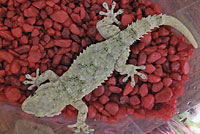 |
 |
 |
 |
| Adult © Monte Lininger The Moorish Gecko gets up to 6 inches long including the tail (15 cm) which is smaller than the Ringed Wall Gecko. |
Adult © Patrick Briggs |
Adult © Patrick Briggs This gecko is sometimes confused with the sympatric Mediterranean Gecko which is smaller in size and has smaller and more numerous tubercles. |
Adult | The Moorish Gecko has white blotches but they occur more randomly than the white spots on the Ringed Wall Gecko. |
Tiny juvenile about 2 inches long including tail. © Marc Hawkins | Red dots show some of the areas where this lizard has been introduced |
|
| Rough-tailed Gecko Cyrtopodion scabrum |
 |
 |
 |
 |
 |
 |
 |
| © Elliot Jaramillo Adults are small - 3 to 4 and 5/8 inches long (7.5 - 11.7 cm) including the tail. |
Adult © Elliot Jaramillo | Adult © William Flaxington | Tail is covered with rough keeled scales. Compare with the smoother tail of the Mediterranean Gecko. |
Toes are thin with no pads on the tips. Compare with the padded toes of the Mediterranean Gecko. |
Body is covered with lots of large keeled scales. |
Red dots show some of the areas where this lizard has been introduced |
|
| Miscellaneous Non-native Lizards |
|||||||
Sonoran Spotted Whiptail Aspidoscelis sonorae
|
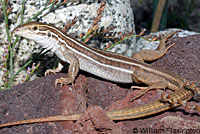 |
 |
 |
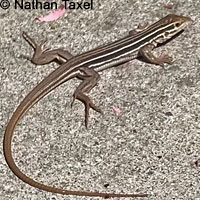 |
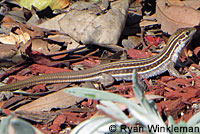 |
 |
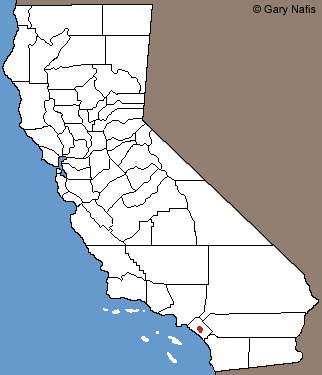 |
| Adult © William Flaxington Smaller than the native Western Whiptail, adults average 3.5 inches (9 cm) in length, not including the tail. |
Adult © Ryan Winkleman | Adults have 6 distinct light stripes on the back with light spots in the dark fields between the stripes. The paravertebral stripes (the two stripes on either side of the middle of the back) remain parallel on the back and fade out on the tail. (Compare with the paravertebral stripes on the Orange-throated Whiptail, which merge together on the back and become a single mid-dorsal stripe that extends onto the tail.) |
Adult © Nathan Taxel Because of the light and dark stripes on the back, adults and juveniles are sometimes confused with the native Belding's Orange-throated Whiptail. |
Adult © Ryan Winkleman | Juvenile © William Flaxington | Red dots show some of the areas where this lizard has been introduced |
|
African Five-lined Skink Trachylepis Quinquetaeniata |
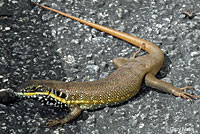 |
 |
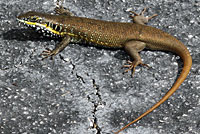 |
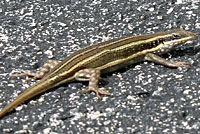 |
 |
 |
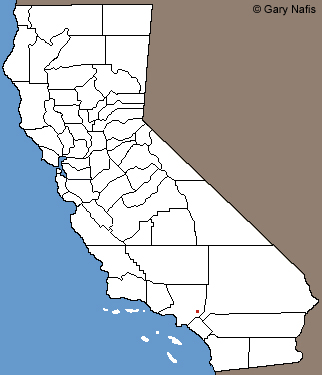 |
| A stocky skink with smooth shiny skin, a cylindrical body, pointed snout, and long toes. The body grows up to 5.25 inches long, not including the tail and the tail can be 5 to almost 8 inches long. |
Adult males show a bright yellow stripe on the sides of the head and upper body. This skink has become established in a few suburban neighborhoods in the eastern San Gabriel Valley in L.A. county. |
Adult male. Males lack the stripes found on females. |
Adult female with longitudinal stripes. The wide body and striped back on females can cause them to be confused with the native Skilton's Skink. |
Adult male | Adult male | Red dot shows the area where this lizard has been introduced | |
Jackson's Chameleon Trioceros (Chamaeleo) jacksonii |
 |
 |
 |
 |
 |
 |
 |
A large, thick-bodied arboreal lizard with a prehensile tail that can be coiled when not used to help with climbing. Average total length including tail is 10 inches (25.4 cm). |
Adult male Males have three horn-like projections at the front of the head. |
Adult female | This species is able to rapidly change color. These are 3 color variations of the same adult female chameleon that occured shortly after she was captured from the wild. |
Red dots show some of the areas where this lizard has been introduced |
|||
Italian Wall Lizard Podaris siculus |
 |
 |
 |
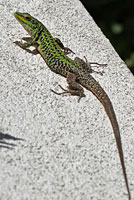 |
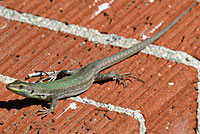 |
 |
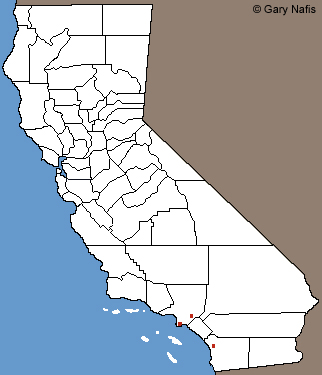 |
| This European species has become established in San Pedro in L.A. County, and San Marcos in San Diego County. It has adapted to living in suburban yards and is typically seen on walls and fences. |
Adult | This species is highly variable in appearance. Color can be green, yellowish, olive, or light brown, with a dark checkered or reticulated pattern on the sides that may extend onto the back, which sometimes form stripe-like streaks. Some indivisuals have a faint pattern or none at all. | Adults grow as large as 3.5 inches long (9 cm) not including the tail, which can be up to twice the body length. | Adult | Italian Wall Lizards have small granular scales on the back. | Red dots show some of the areas where this lizard has been introduced |
|
| Ocellated Bronze Skink (Ocellated Bronze Skink, Eyed Skink, Gongilo) Chalcides ocellatus |
 |
 |
|||||
| This non-native species is known so far only from a couple of inhabitated locations in Southern California, but it is likely to spread farther given its adaptability. The only native California it resembles somewhat is the Gilbert's Skink. | © Svdmolen - Wickipedia | Red dots show some of the areas where this lizard has been introduced |
|||||
 |
|||||||
Return to the top
© 2000 -
